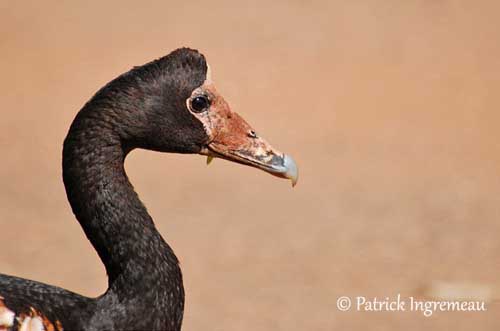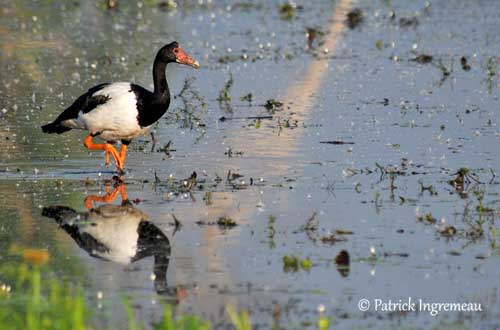
Fr: Canaroie semipalmée
All : Spaltfußgans
Esp : Ganso Urraco
Ital : Oca gazza
Nd: Ekstergans
Sd: Skatgås
Photographers:
Jean Michel Fenerole
Photos d’Oiseaux du monde
Patrick Ingremeau
TAMANDUA
Text by Nicole Bouglouan
Sources:
HANDBOOK OF THE BIRDS OF THE WORLD vol 1 by Josep del Hoyo-Andrew Elliot-Jordi Sargatal - Lynx Edicions - ISBN: 8487334105
L’ENCYCLOPEDIE MONDIALE DES OISEAUX - Dr Christopher M. Perrins - BORDAS - ISBN: 2040185607
GUIDE DES CANARDS, DES OIES ET DES CYGNES – de Steve Madge - Delachaux et Niestlé - ISBN: 2603013769
BIRDS OF AUSTRALIA by Peter Rowland – Ed: Louise Egerton - ISBN: 1864363436
BirdLife International (BirdLife International)
Birds in backyards (Birds Australia and Australian Museum)
ANIMALS – Explore, discover, connect
Magpie Goose
Anseranas semipalmata
Anseriforme Order – Anseranatidae Family
BIOMETRICS:
Male: Length: 75-90cm – Wingspan: 130-180 cm – Weight: 2800 g
Female: Length: 70-80 cm – Wingspan: 125-165 cm – Weight: 2000 g
DESCRIPTION:
The Magpie Goose is a very peculiar species, usually more terrestrial than other Anseriformes.This bird is a mix of duck and goose by its appearance, but actually, it is more often considered an evolutionary link between the Anatidae species and the more terrestrial screamers of the family Anhimidae.
It is the only member of the family Anseranatidae, closer to screamers than ducks and geese.
The adult has black and white plumage. It has black head, neck, upper breast, wings, rump, tail and thighs.
The underparts, underwing-coverts, mantel, lesser upperwing-coverts and uppertail-coverts are white.
On the head, the male has a protuberance at the top of the crown, varying in size. The facial skin is red. The bill is greyish-horn with red cere. The eyes are dark brown. Legs and semipalmated feet are orange to reddish.

During the dry season, the underparts are often tinged rufous, due to stagnant muddy waters.
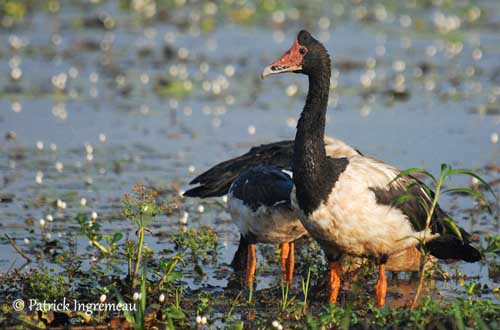
The female has similar plumage but she is smaller with smaller knob on crown.
The juvenile is greyer and mottled. It has dull black areas, and white, washed brownish rest of plumage. Bill and facial skin are grey. The knob is absent and grows little by little.
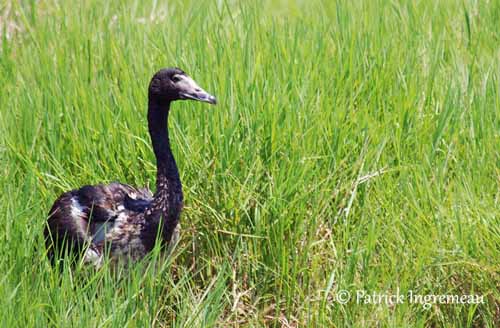
VOICE: SOUNDS BY XENO-CANTO
The Magpie Geese are noisy when in flocks. They call both in flight and on the ground, giving loud honks as true geese.
The male on the ground calls quietly while raising the head, but it also gives rapid series of calls, and usually, all the flock follows and calls too.
When a male is calling, one or several females call in response.
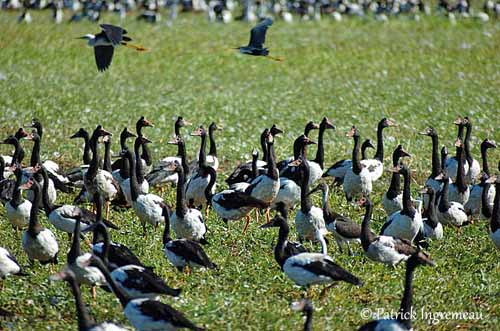
HABITAT:
The Magpie Goose frequents the marshy areas with dense vegetation, both in fresh and brackish waters. It is often seen in grasslands in floodplains along the tropical rivers. These areas are usually subject to great variation of water levels. This species is never far from the coasts.
RANGE:
The Magpie Goose occurs in N Australia and S New Guinea. The species has been reintroduced in Victoria where it was formerly widespread.
BEHAVIOUR:
The Magpie Goose is vegetarian and feeds primarily on aquatic plants, but it also takes seeds of grasses, bulbs and rhizomes.
It feeds on the ground, digging with the strong bill to reach bulbs and roots. But as other Anseriformes, it also feeds by grazing, and by filtering the mud in wet and marshy areas.
It can feed as well on the ground as in the water by walking, swimming and up-ending.
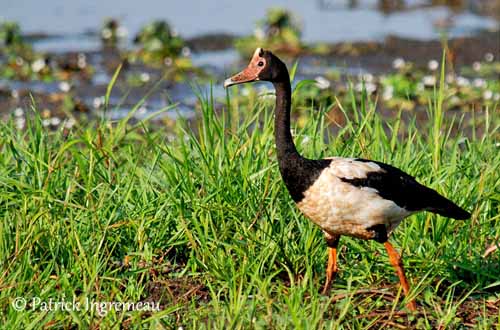
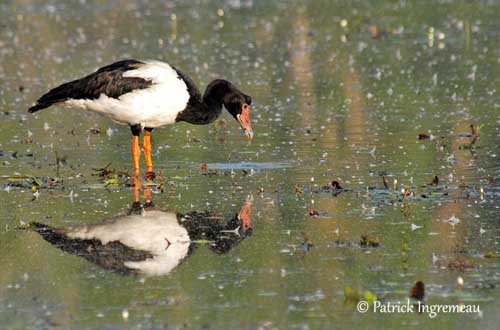
The Magpie Goose is gregarious all year round. They form family groups after the reproduction, and join large flocks in suitable habitats.
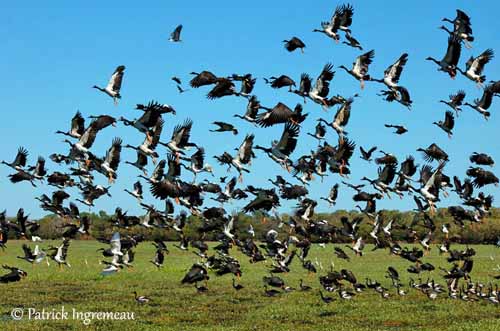
Some threat displays can be observed. The male approaches the opponent with the head held slightly back and making a strong thrust with the open bill equipped with sharp nail. It also may fly at the opponent and strikes it with feet, wings and bill.
The Magpie Goose is regularly polygamous with peculiar mating system. One male is paired with one or two females which lay in the same nest. The three adults share the incubation, but usually, the male remains in the vicinity of the nest when the female is incubating, and it may incubate too when she leaves the nest for feeding. It also takes an active part in the rearing of the young, and helps the female in the building of the nest.
The copulation usually occurs on or near the nest-site. The bonds of the pair or trio probably last for life.
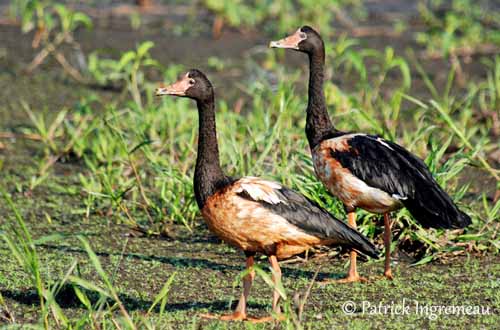
The Magpie Goose wanders widely according to the food and water resources, and especially during the dry season. But the species is not really migratory.
However, the young birds are seen quite long distances inland.
FLIGHT:
The Magpie Goose has fairly slow and heavy flight in spite of its large wings.
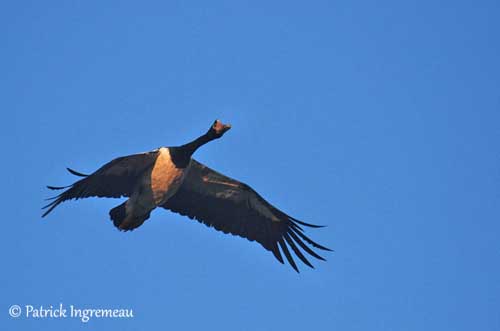
REPRODUCTION:
The breeding season starts at the beginning of the wet season, February-April in North, and August-September in South.
The Magpie Goose forms relatively large colonies. The nest is built by both sexes. That is a large pile of spike-rush and floating vegetation. The stems are trampled with the feet in the water before to be used.
One or two females lay in the same nest 5-11 off-white eggs, sometimes up to 16 eggs. The adults share the incubation during 23-25 days.
At hatching, the chicks are covered with grey down, whiter below. Head and neck are cinnamon. They fledge 11 weeks after hatching.
The Magpie Goose has a unique behaviour in Anseriformes: the adults feed the chicks bill to bill first, and later, they bend the grasses with their feet and the chicks can reach and eat the seeds.
Hard dry seasons and predators may cause reduced breeding success.

DIET:
The Magpie Goose feeds on plant matter such as blades and seeds of grasses, bulbs and rhizomes.
PROTECTION / THREATS / STATUS:
The Magpie Goose has suffered decline due to habitat loss and persecution by man during the 19th century. The species is now increasing with the reintroduction in Victoria.
These birds sometimes damage pastures and ricefields, involving hunting by farmers. Hunting is legal in the Northern territory, but the species is protected elsewhere. However, the Aborigines still hunt them.
The breeding areas are threatened by several problems such as settlements, agriculture, grazing, drainage of wetlands and introduction of Mimosa pigra, an invasive plant of Fabacae family. This plant forms dense shrubland, unsuitable for breeding.
But currently, this species is not threatened.
